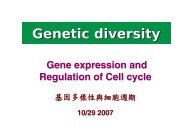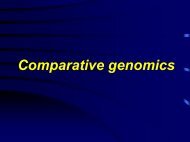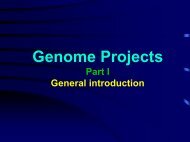Advertisement
Advertisement
Advertisement
- No tags were found...
Create successful ePaper yourself
Turn your PDF publications into a flip-book with our unique Google optimized e-Paper software.
databases to review potential alleles and minor allelefrequency.— Darryl IrwinAll else being equal, one would prefer to designassays for those SNPs most likely to convert toworking assays. For each query SNP, the sequencearound it will be available from at least two (andhopefully more) alleles. There are several propertiesof the flanking sequence that will influence whetherthe query SNP yields accurate genotypes: GCcontent, sequence repetitiveness, and sequencepolymorphism are three of the important ones. SNPsin very AT-rich sequence and those within highlyrepetitive regions are less likely to result in convertingassays, due to instability of hybridization betweengenotyping probes and their targets. Also, ifthe sequence is very polymorphic around the querySNP, it may not be possible to design allele- orSNP-specific genotyping probes. Segregatingpolymorphisms can and do interfere with thehybridization of genotyping probes to their targets,and can adversely impact the accuracy of thegenotype data.— Stuart MacdonaldFor mapping using SNPs, it is important to haveSNPs that are evenly distributed throughout thegenome. We have made consensus maps forArabidopsis recombinant inbred lines with arecurrent parent. In this case, it was important tochoose SNPs that distinguish the recurrent parentfrom all the other accessions. For functional studies,SNPs that cause non-conservative amino acidchanges are prioritized. Another possibility whenfunctional information is lacking is to choose asubset of SNPs to genotype that represent thedifferent haplotypes. Once SNPs have been chosen,there may be technical constraints for theirgenotyping; additional adjacent SNPs are usually notallowed and for multiplex methods, there must becompatibility between the SNPs.— Heather McKhannLiterature searches in related research areas giveinput on interesting candidate genes and SNPs.Databases such as NCBI and HapMap provide toolsfor selecting frequent SNPs and showing haplotypeblocks and tag SNPs.— Louise NordforsSearching for candidate SNPs on the basis of theirputative functionality is a lottery. I try to capture thehaplotype diversity using SNPs according to (i)Celera, (ii) Perlegen, and (iii) HapMap, usually in nonconserved,intronic regions and taking into accountthe informativity (frequency of 30 percent to 50percent) and covering the different haplotype blocks.— Jose Luis RoyoSNP scoring, such as the criteria given by Illumina SNPscoring algorithm, and htSNPs, generated by theHapMap Project. Generally speaking, we willconsider genotyping SNPs at a 10 kb to 50 kb densityfor general studies on human diseases.— Huanming YangGenome Technology SNP Genotyping Tech Guide 9






